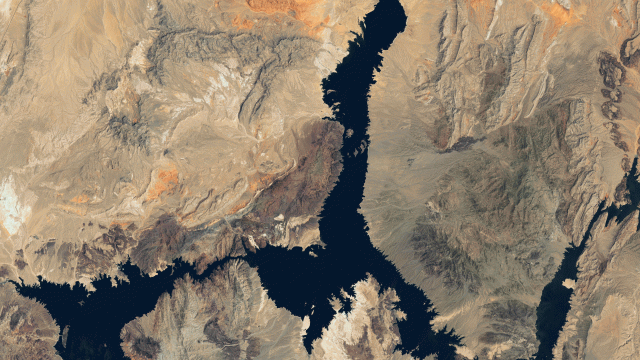Every day, Lake Mead seems to be less deserving of its title. The waterbody has officially reached yet another historic low. The reservoir is now less full than in April 1937, when it was still being filled for the first time. It is hovering around 27% of its full capacity, according to NASA Earth Observatory. Satellite images from NASA, released today, are a stark illustration of Mead’s plight.
Before Lake Mead was a lake, it was simply a stretch of the Colorado River. Then the U.S. Bureau of Reclamation initiated the construction of the Hoover Dam, which was built between 1931 and 1935. And slowly, the river became a reservoir — filling to capacity over the course of years.
The reservoir reached a benchmark in May 1937, when the surface water level became higher than the elevation of the Hoover Dam’s upper outlet, which allows the dam to release water into the Lower Colorado River. Until this summer, Lake Mead hadn’t fallen below that threshold since it was first crossed. But the dam’s upper outlet sits at 318.52 m above sea level, and currently the water is at just 316.99 m.
This time last year, the lake level was nearly 8.23 m higher. In 2020, the water level was over 330.71 m. Lake Mead’s water level has been consistently trending downward for the past 22 years, but the present culmination of that trend is startling to see.
The ongoing, record drought across much of the western and southwestern U.S. and climate change are big contributing factors in the reservoir’s most recent benchmark of decline. It’s dry, it’s hot, and both municipal and agricultural demand for water from the Colorado River has remained high, even amid increasing water restrictions.
Some of the low levels though, are because federal officials decided to reduce water releases to Lake Mead, in favour of preserving the levels at Lake Powell upstream — which has also been heavily impacted by the drought and is also at just 27% of its capacity. The entire Colorado River is at 35%.
In addition to providing water across the arid West, both reservoirs are a critical hydroelectric energy source. But Lake Mead is inching dangerously close to “dead pool” levels, where there won’t be enough water to power the dam. Dead pool happens at a water elevation of 289.56 m. Because of low water, the Hoover Dam’s electricity production has already been reduced by about one third.
